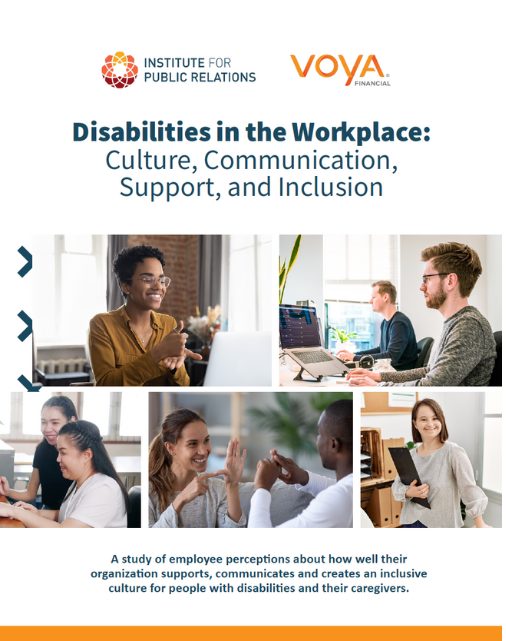
Disabilities in the Workplace: Culture, Communication, Support, and Inclusion
Download the Full Report : Disabilities in the Workplace Report (PDF)Watch the Webinar: Disabilities in the Workplace Report DiscussionDownload the Press Releases: News release for Communications Professionals (PDF)News Release for Human Resources (PDF)

 Institute for Public Relations and Voya Financial have partnered on a comprehensive report, “Disabilities in the Workplace: Culture, Communication, Support, and Inclusion” that analyzes a survey of 1,014 employees to determine how organizations support and communicate about disabilities and caregiving in the workplace.
Institute for Public Relations and Voya Financial have partnered on a comprehensive report, “Disabilities in the Workplace: Culture, Communication, Support, and Inclusion” that analyzes a survey of 1,014 employees to determine how organizations support and communicate about disabilities and caregiving in the workplace. Introduction: Little research has been conducted regarding employee perceptions of diversity priorities and inclusion and how well initiatives and programs are communicated within organizations. In 2020, according to the U.S. Bureau of Labor Statistics, 17% of people with a disability were employed compared to the 61% of people without a disability. According to a report from Bentley University, more than two-thirds of disabilities are “invisible,” meaning disabilities cannot be observed or are not visually detectable. The Bentley University report also found that while more than two-thirds of workplace leaders believe their technological arrangements and cultures are supportive of employees with disabilities, fewer than half of those with disabilities agree.While Disability:IN has seen participation in its annual Disability Equality Index increase year-over- year, an Institute for Public Relations (IPR) study found executive support of those with disabilities may not be communicated effectively through organizations. In the 2021 IPR Language of Diversity study, of communication professionals, only 24% said, “physical abilities and disabilities” were rated as a “high priority” for their organization’s diversity, equity and inclusion (DE&I)initiatives, while only 14% said the same about neurodiversity (e.g., ADHD, autism, etc.). Compared to other categories of diversity, disabilities was one of the lowest-ranked. Disabilities or becoming a caregiver of those with disabilities can affect anyone at any point in their lives.In January 2023, IPR and Voya Financial surveyed 1,014 employees in organizations with more than 15 full-time employees to determine how well organizations communicate about and support disabilities and inclusion in the workplace.
Full Report:
Some Key Findings: More than half of people with disabilities have witnessed or experienced both macroaggressions and microaggressions toward individuals with disabilities at least a few times a year in the workplace.
Introduction: Little research has been conducted regarding employee perceptions of diversity priorities and inclusion and how well initiatives and programs are communicated within organizations. In 2020, according to the U.S. Bureau of Labor Statistics, 17% of people with a disability were employed compared to the 61% of people without a disability. According to a report from Bentley University, more than two-thirds of disabilities are “invisible,” meaning disabilities cannot be observed or are not visually detectable. The Bentley University report also found that while more than two-thirds of workplace leaders believe their technological arrangements and cultures are supportive of employees with disabilities, fewer than half of those with disabilities agree.While Disability:IN has seen participation in its annual Disability Equality Index increase year-over- year, an Institute for Public Relations (IPR) study found executive support of those with disabilities may not be communicated effectively through organizations. In the 2021 IPR Language of Diversity study, of communication professionals, only 24% said, “physical abilities and disabilities” were rated as a “high priority” for their organization’s diversity, equity and inclusion (DE&I)initiatives, while only 14% said the same about neurodiversity (e.g., ADHD, autism, etc.). Compared to other categories of diversity, disabilities was one of the lowest-ranked. Disabilities or becoming a caregiver of those with disabilities can affect anyone at any point in their lives.In January 2023, IPR and Voya Financial surveyed 1,014 employees in organizations with more than 15 full-time employees to determine how well organizations communicate about and support disabilities and inclusion in the workplace.
Full Report:
Some Key Findings: More than half of people with disabilities have witnessed or experienced both macroaggressions and microaggressions toward individuals with disabilities at least a few times a year in the workplace.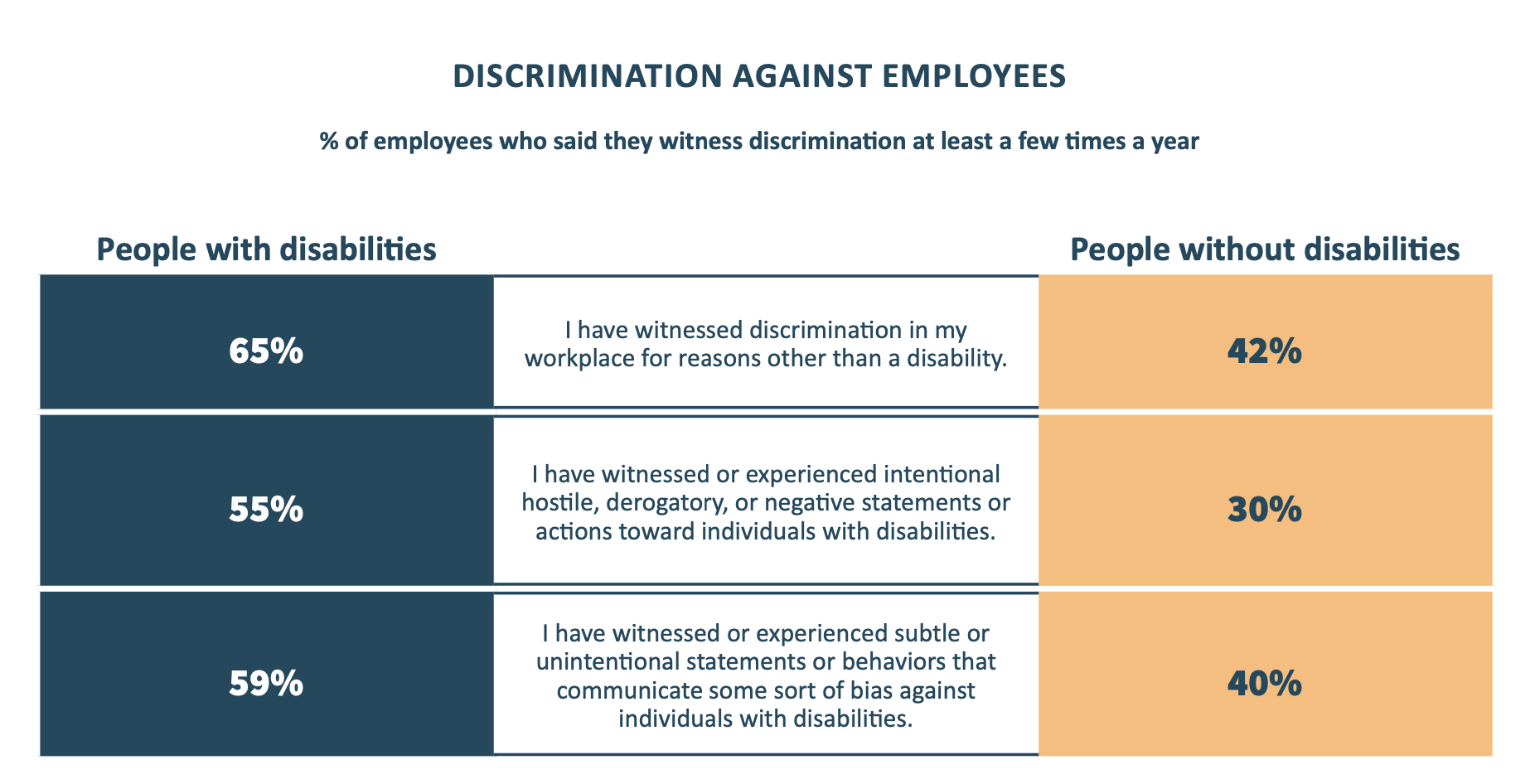 Forty percent of respondents were not familiar with the organization’s position or strategic plan related to disabilities in the workplace.Only slightly more than one-third of employees were “very familiar” with an organization’s position or strategic plan on how best to support individuals with a disability. In fact, 4-in-10 respondents were unfamiliar or “slightly familiar” with their organization’s plan. For organizations to be effective with their programs, employees must be well-versed in the strategy as they influence the culture of the organization.Slightly more than half of employees said their company effectively communicated internally and externally about leadership’s commitment to disability inclusion.
Forty percent of respondents were not familiar with the organization’s position or strategic plan related to disabilities in the workplace.Only slightly more than one-third of employees were “very familiar” with an organization’s position or strategic plan on how best to support individuals with a disability. In fact, 4-in-10 respondents were unfamiliar or “slightly familiar” with their organization’s plan. For organizations to be effective with their programs, employees must be well-versed in the strategy as they influence the culture of the organization.Slightly more than half of employees said their company effectively communicated internally and externally about leadership’s commitment to disability inclusion.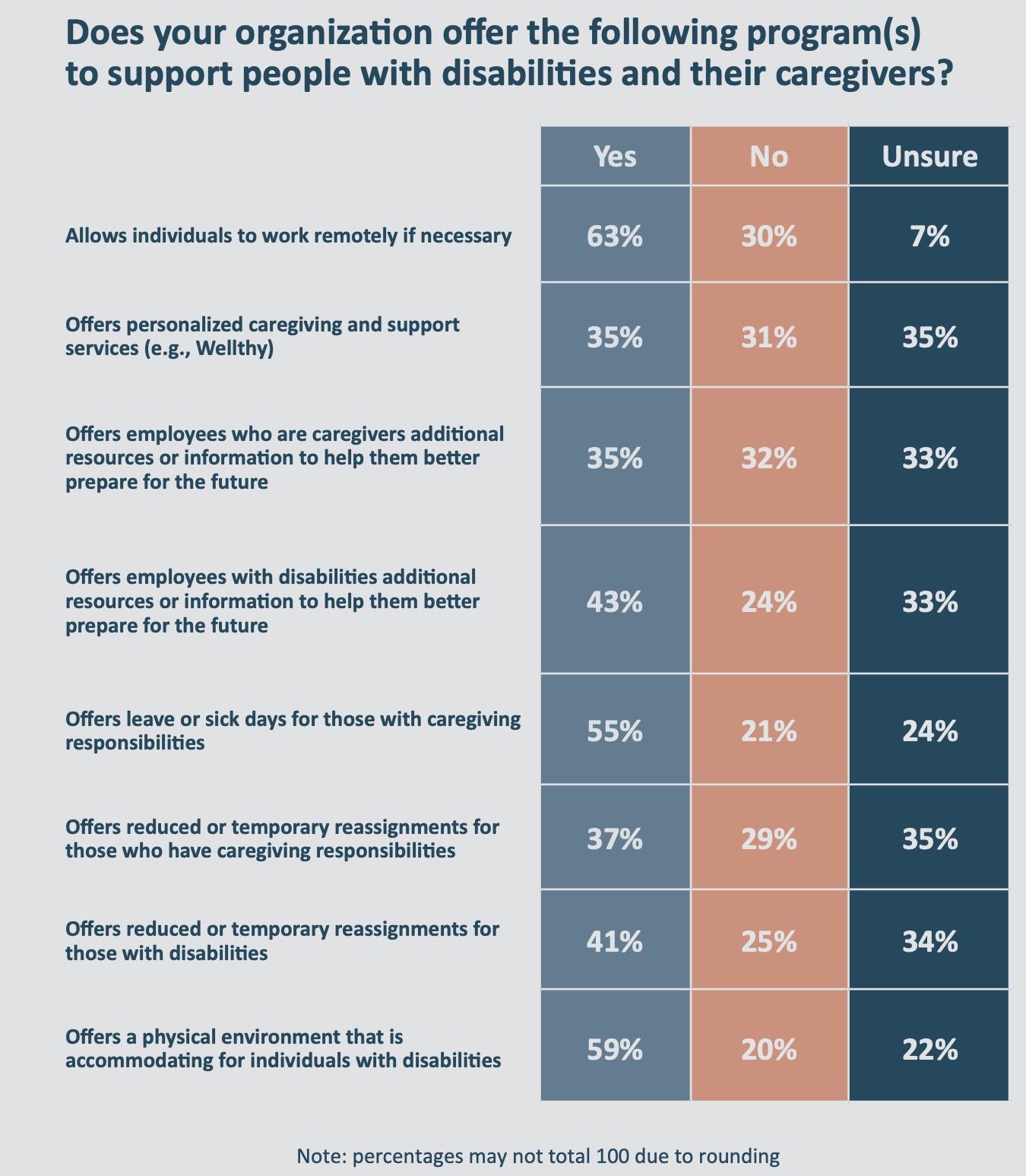 Both employees with and without disabilities wanted to learn more about disability inclusion within the organization.More than half of their employees (53%) without disabilities and 72% of those with disabilities were interested in learning more about disabilities within their organization, offering a great opportunity for organizations.Despite nearly three-quarters (73%) of employees saying they want to see people with disabilities represented in commercials, advertisements, and social media, only one-third said their organization actually features people with disabilities on these channels. Only 36% said their company featured individuals with disabilities in commercials or advertisements and 39% said they were included in their internal or employee-focused communications (39%).People with disabilities and caregivers thought their organizations did a better job communicating about supporting people with disabilities and their caregivers than people without disabilities.
Both employees with and without disabilities wanted to learn more about disability inclusion within the organization.More than half of their employees (53%) without disabilities and 72% of those with disabilities were interested in learning more about disabilities within their organization, offering a great opportunity for organizations.Despite nearly three-quarters (73%) of employees saying they want to see people with disabilities represented in commercials, advertisements, and social media, only one-third said their organization actually features people with disabilities on these channels. Only 36% said their company featured individuals with disabilities in commercials or advertisements and 39% said they were included in their internal or employee-focused communications (39%).People with disabilities and caregivers thought their organizations did a better job communicating about supporting people with disabilities and their caregivers than people without disabilities.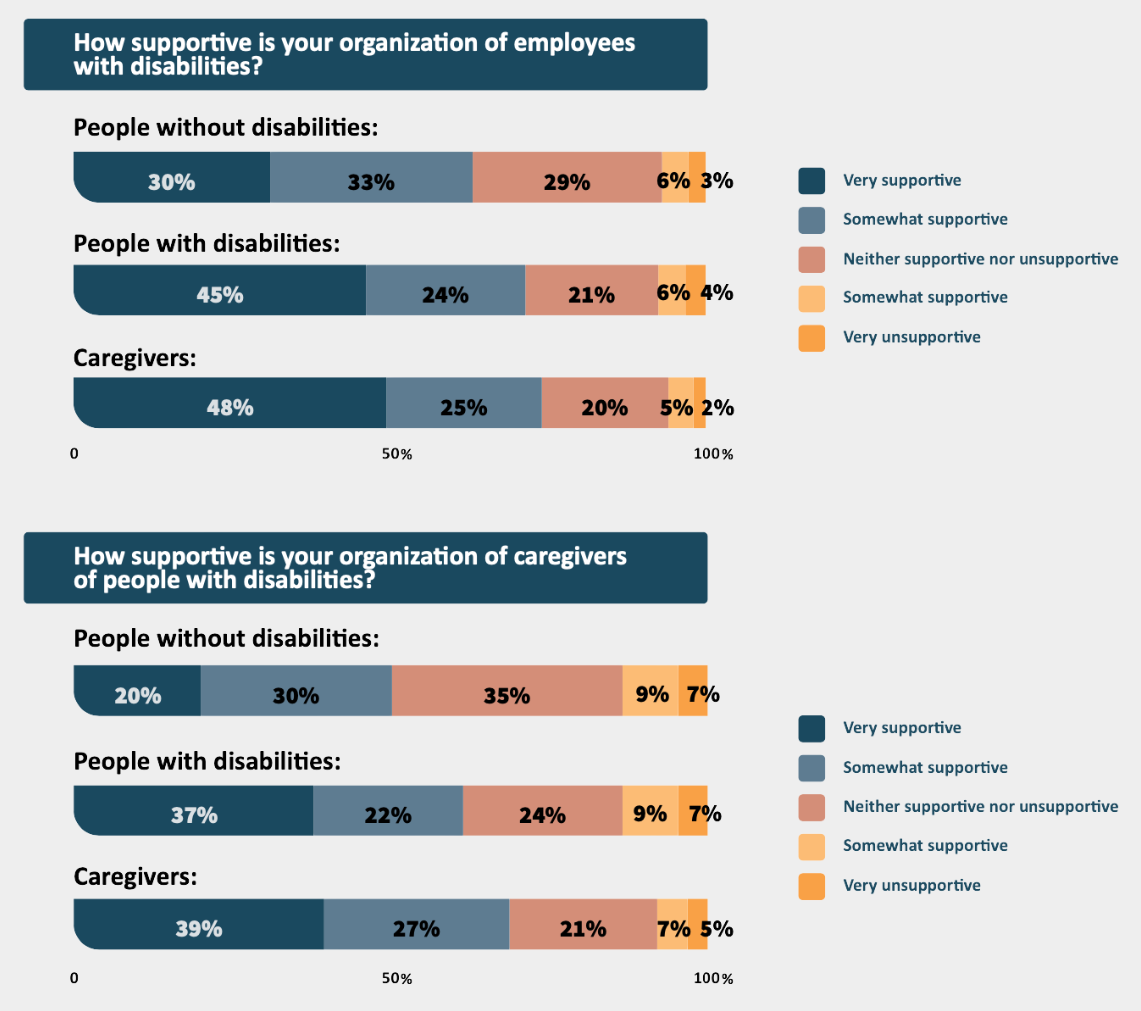 One-in-three people who have a disability and one-in-five caregivers have not disclosed their disability or caregiving responsibilities to their employer.At least 4-in-10 respondents with disabilities had to scale back their hours (41%) or leave their job (49%) due to their disability, affecting retention. Similarly, nearly 5-in-10 caregivers (48%) had to scale back their hours and 34% had to leave their job. People who did not disclose their disability to their employer were concerned about being fired, ridiculed, orretaliated against.
Methodology: IPR and Voya Financial surveyed 1,014 employees in organizations with more than 15 full-time employees to determine how well organizations communicate about and support disabilities and inclusion in the workplace.One hundred and eighty-seven respondents identified as an individual with disabilities either currently or in the past, and 242 respondents said they had or have had caregiving responsibilities for an individual with a disability. Prior to taking the survey, employees were provided definitions of the scope of disabilities and the definition of a caregiver for consistency purposes (see Appendix for definitions and methodology).*IPR is a separate entity and not a corporate affiliate of Voya Financial®.
One-in-three people who have a disability and one-in-five caregivers have not disclosed their disability or caregiving responsibilities to their employer.At least 4-in-10 respondents with disabilities had to scale back their hours (41%) or leave their job (49%) due to their disability, affecting retention. Similarly, nearly 5-in-10 caregivers (48%) had to scale back their hours and 34% had to leave their job. People who did not disclose their disability to their employer were concerned about being fired, ridiculed, orretaliated against.
Methodology: IPR and Voya Financial surveyed 1,014 employees in organizations with more than 15 full-time employees to determine how well organizations communicate about and support disabilities and inclusion in the workplace.One hundred and eighty-seven respondents identified as an individual with disabilities either currently or in the past, and 242 respondents said they had or have had caregiving responsibilities for an individual with a disability. Prior to taking the survey, employees were provided definitions of the scope of disabilities and the definition of a caregiver for consistency purposes (see Appendix for definitions and methodology).*IPR is a separate entity and not a corporate affiliate of Voya Financial®.
![]() About the Institute for Public RelationsFounded in 1956, the Institute for Public Relations is an independent, nonprofit foundation dedicated to the science beneath the art of public relations™. IPR creates, curates, and promotes research and initiatives that empower professionals with actionable insights and intelligence they can put to immediate use. IPR predicts and analyzes global factors transforming the profession and amplifies and engages the profession globally through thought leadership and programming. All research is available free at www.instituteforpr.org and provides the basis for IPR’s professional conferences and events.Media Contact:Brittany HigginbothamCommunications & Digital Specialistbrittany@instituteforpr.org352-392-0280
...
About the Institute for Public RelationsFounded in 1956, the Institute for Public Relations is an independent, nonprofit foundation dedicated to the science beneath the art of public relations™. IPR creates, curates, and promotes research and initiatives that empower professionals with actionable insights and intelligence they can put to immediate use. IPR predicts and analyzes global factors transforming the profession and amplifies and engages the profession globally through thought leadership and programming. All research is available free at www.instituteforpr.org and provides the basis for IPR’s professional conferences and events.Media Contact:Brittany HigginbothamCommunications & Digital Specialistbrittany@instituteforpr.org352-392-0280
...

 The Associated Press and the National Opinion Research Center (NORC) at the University of Chicago examined Americans’ confidence levels in science and medicine related to their political affiliation.A survey of 3,544 U.S. adults was conducted May 5 – Dec. 20, 2022.Key findings include:— 39% of U.S. adults overall said they had “a great deal of confidence” in the scientific community.—– This number is down from 48% in 2021.—– 53% of Democrats reported “a great deal of confidence” in the scientific community compared to 55% in 2018.—– 22% of Republicans said they had “a great deal of confidence” in the scientific community compared to 45% in 2018.— 34% of Americans reported “a great deal of confidence” in medicine, compared to 39% before the pandemic.— Although confidence in the scientific community has declined in recent years, this community is still more trusted than other institutions in America including the press (7%), organized religion (19%), and education (25%).Full report here
...
The Associated Press and the National Opinion Research Center (NORC) at the University of Chicago examined Americans’ confidence levels in science and medicine related to their political affiliation.A survey of 3,544 U.S. adults was conducted May 5 – Dec. 20, 2022.Key findings include:— 39% of U.S. adults overall said they had “a great deal of confidence” in the scientific community.—– This number is down from 48% in 2021.—– 53% of Democrats reported “a great deal of confidence” in the scientific community compared to 55% in 2018.—– 22% of Republicans said they had “a great deal of confidence” in the scientific community compared to 45% in 2018.— 34% of Americans reported “a great deal of confidence” in medicine, compared to 39% before the pandemic.— Although confidence in the scientific community has declined in recent years, this community is still more trusted than other institutions in America including the press (7%), organized religion (19%), and education (25%).Full report here
... 
 Pew Research Center examined journalists’ concerns and perspectives on changes in the news industry.A survey of 11,889 U.S.-based journalists was conducted from Feb. 16 – March 17, 2022. Key findings include:— 57% of journalists say they are extremely or very concerned about possible restrictions on U.S. press freedoms.— Journalists aged 65+ years were the most concerned age group; 42% reported they are feeling extremely concerned.—– 39% in the 50-64 year old age group were extremely concerned, followed by ages 30-49 (28%) and ages 18-29 (20%). — 65% of journalists who have more than 20 years of experience are extremely or very concerned about press freedoms, compared to 45% of journalists with five years or less.— Concern remains consistent across types of news outlets and local, state or national news.—– 59% of journalists who work for news sources with right-leaning audiences and 56% of those who work for news sources with left-leaning audiences are extremely or very concerned about press freedoms.Discover how journalists perceive the future of the news industry
...
Pew Research Center examined journalists’ concerns and perspectives on changes in the news industry.A survey of 11,889 U.S.-based journalists was conducted from Feb. 16 – March 17, 2022. Key findings include:— 57% of journalists say they are extremely or very concerned about possible restrictions on U.S. press freedoms.— Journalists aged 65+ years were the most concerned age group; 42% reported they are feeling extremely concerned.—– 39% in the 50-64 year old age group were extremely concerned, followed by ages 30-49 (28%) and ages 18-29 (20%). — 65% of journalists who have more than 20 years of experience are extremely or very concerned about press freedoms, compared to 45% of journalists with five years or less.— Concern remains consistent across types of news outlets and local, state or national news.—– 59% of journalists who work for news sources with right-leaning audiences and 56% of those who work for news sources with left-leaning audiences are extremely or very concerned about press freedoms.Discover how journalists perceive the future of the news industry
... 
 WE Communications and the USC Annenberg Center for Public Relations examined how communications leaders are responding to the recent uptick of interest in AI. The study specifically measured practitioners’ levels of excitement and concern.A survey of roughly 400 communications leaders was conducted in April 2023.Key findings include:— 80% of respondents said AI will be extremely or very important to the future of PR work.— 16% of respondents said they were extremely knowledgeable about the applications of AI in communications.—– 59% of respondents said they already have or are looking for ways to incorporate ChatGPT into their work.— 23% of respondents said their organizations are changing the way they work due to new AI tools.—– 88% of respondents said AI will increase the efficiency of their work.—– 72% or respondents said it will reduce workloads.— 25% of respondents think that AI will negatively impact creativity.— 87% of respondents said the ability to write good AI prompts will become a more important skill to have.—– Other important skills included having knowledge on human-computer interaction (82%), strategic thinking (79%), and data analytics experience (75%).Discover what communications leaders are saying about AI
...
WE Communications and the USC Annenberg Center for Public Relations examined how communications leaders are responding to the recent uptick of interest in AI. The study specifically measured practitioners’ levels of excitement and concern.A survey of roughly 400 communications leaders was conducted in April 2023.Key findings include:— 80% of respondents said AI will be extremely or very important to the future of PR work.— 16% of respondents said they were extremely knowledgeable about the applications of AI in communications.—– 59% of respondents said they already have or are looking for ways to incorporate ChatGPT into their work.— 23% of respondents said their organizations are changing the way they work due to new AI tools.—– 88% of respondents said AI will increase the efficiency of their work.—– 72% or respondents said it will reduce workloads.— 25% of respondents think that AI will negatively impact creativity.— 87% of respondents said the ability to write good AI prompts will become a more important skill to have.—– Other important skills included having knowledge on human-computer interaction (82%), strategic thinking (79%), and data analytics experience (75%).Discover what communications leaders are saying about AI
... 
 This summary is provided by the IPR Digital Media Research CenterMorning Consult explored Americans’ trust in artificial intelligence (AI) companies and support of AI being regulated by the government.A survey of 2,212 U.S. adults was conducted from April 19-22, 2023.Key findings include:— 43% of all respondents said AI companies should be “more regulated” by the government.—– 49% of Democrats said the same, compared to 44% of Republicans.— 36% of Americans overall said they have a “favorable” view of AI companies.—– Millennials had the most favorable views of AI companies (48%), followed by Gen Xers (34%), and Gen Zers (32%).—– Baby Boomers had the least favorable views of AI companies (26%). — While nearly equal shares of adults trust (38%) or distrust (36%) AI companies, major technology firms such as Microsoft and Google fare much better with 52% of respondents saying they trust these firms.—– Democrats (47%) were more likely than Republicans (32%) to say they trust AI companies to “do what is right.”
This summary is provided by the IPR Digital Media Research CenterMorning Consult explored Americans’ trust in artificial intelligence (AI) companies and support of AI being regulated by the government.A survey of 2,212 U.S. adults was conducted from April 19-22, 2023.Key findings include:— 43% of all respondents said AI companies should be “more regulated” by the government.—– 49% of Democrats said the same, compared to 44% of Republicans.— 36% of Americans overall said they have a “favorable” view of AI companies.—– Millennials had the most favorable views of AI companies (48%), followed by Gen Xers (34%), and Gen Zers (32%).—– Baby Boomers had the least favorable views of AI companies (26%). — While nearly equal shares of adults trust (38%) or distrust (36%) AI companies, major technology firms such as Microsoft and Google fare much better with 52% of respondents saying they trust these firms.—– Democrats (47%) were more likely than Republicans (32%) to say they trust AI companies to “do what is right.”
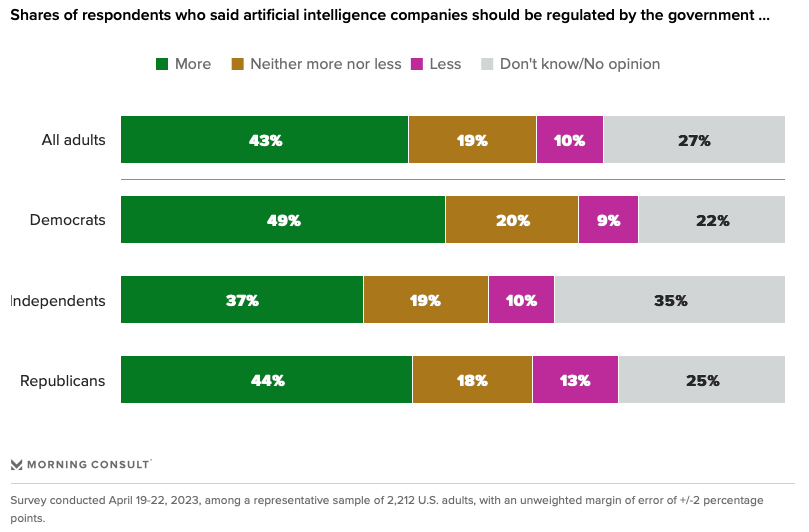 Learn more about Americans’ thoughts on AI companies and regulation
...
Learn more about Americans’ thoughts on AI companies and regulation
... 
 Laura McHale is the Managing Director and Leadership Psychologist Expert at Conduit Consultants Limited. McHale is an expert in assessments, leadership, and team effectiveness. She is the author of Neuroscience for Organizational Communication. She currently serves on the IPR Behavioral Insights Research Center Board of Advisors.
...
Laura McHale is the Managing Director and Leadership Psychologist Expert at Conduit Consultants Limited. McHale is an expert in assessments, leadership, and team effectiveness. She is the author of Neuroscience for Organizational Communication. She currently serves on the IPR Behavioral Insights Research Center Board of Advisors.
... 
 Matt Charles, DPA, APR, teaches Crisis Communications for the Georgetown University School of Continuing Studies Master’s in Public Relations and Corporate Communications program and is President & Founder of Matt Charles Public Relations+Strategy.
...
Matt Charles, DPA, APR, teaches Crisis Communications for the Georgetown University School of Continuing Studies Master’s in Public Relations and Corporate Communications program and is President & Founder of Matt Charles Public Relations+Strategy.
... 

